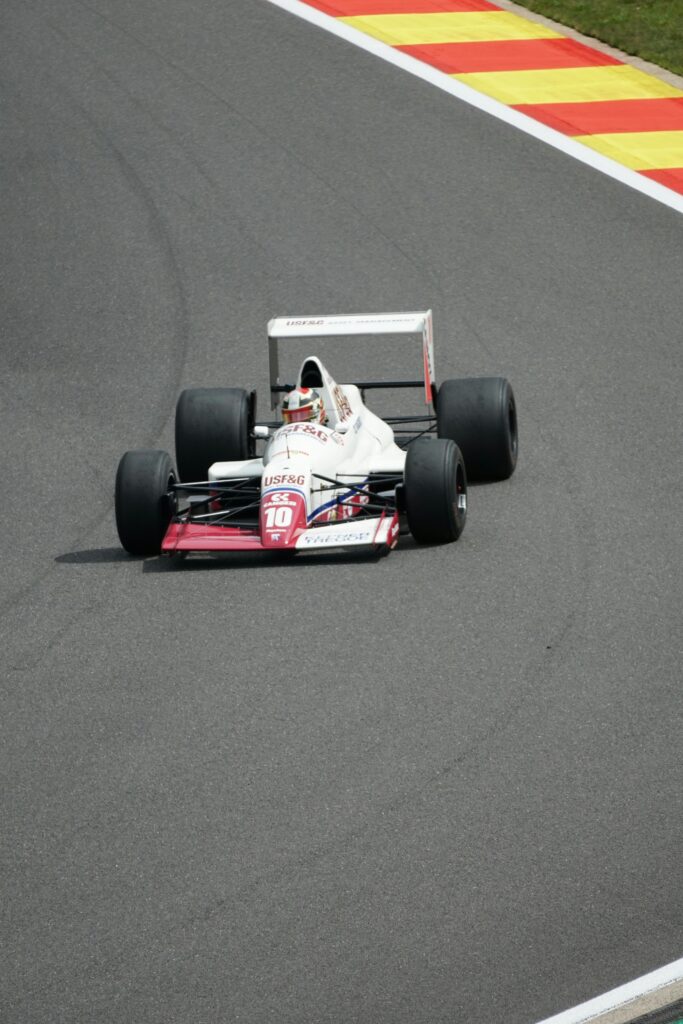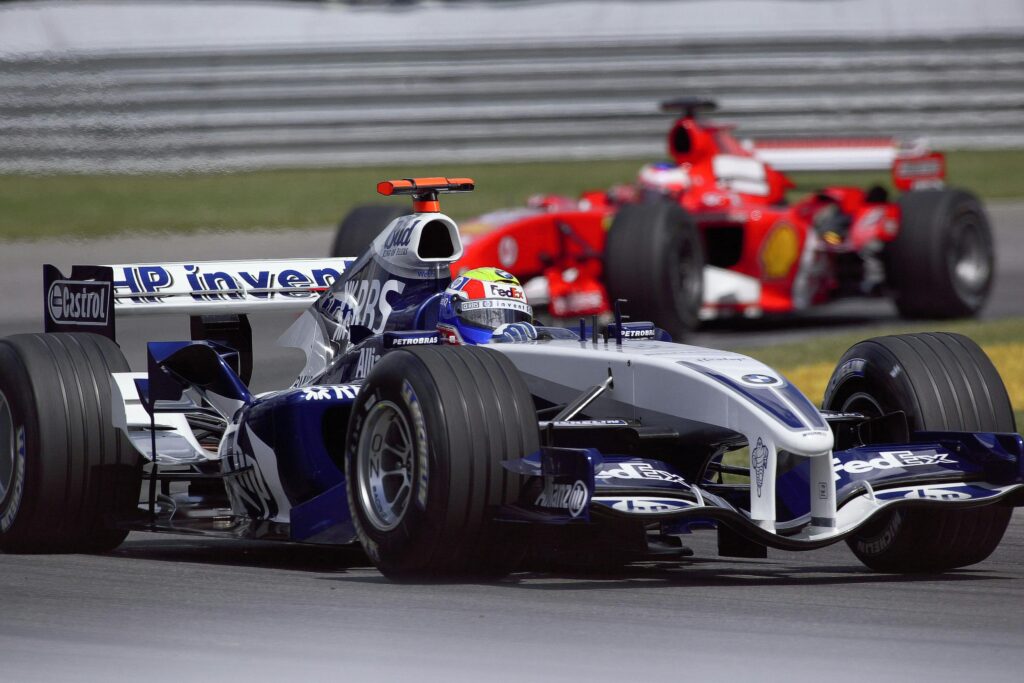Introduction; Formula 1 Car
Formula 1, the pinnacle of motorsport, has captured fans’ imaginations across the globe. But what truly defines a Formula 1 car, and how do these vehicles enable drivers to achieve victory? Whether you’re a devoted F1 follower or a curious newcomer, understanding the science, engineering, and strategy behind these cars offers insights into how every component and decision shapes the journey to the podium. Moreover, This comprehensive guide dives deep into what makes a Formula 1 car an unmatched engineering marvel, and bringing victory closer with every race.

1. The Heart of Speed: Understanding the Formula 1 Car Engine
The engine is the heart of every Formula 1 car, a complex machine crafted for raw power and efficiency. Today’s F1 engines are hybrid power units that combine a turbocharged internal combustion engine with advanced electric systems. This combination allows drivers to unleash over 1,000 horsepower while keeping efficiency in mind. Moreover, this incredible feat has made F1 cars some of the fastest vehicles on earth.
However, sheer power alone isn’t enough. These engines are designed to deliver power in a controlled and efficient manner. Hybrid technology recycles energy during braking, providing extra boosts on the track. Furthermore, this balance between power and efficiency is what gives F1 cars the ability to speed past competitors while staying in line with environmental standards, a requirement in the modern racing world.
Why Engine Power Matters:
- Raw Speed: A powerful engine enables high top speeds, critical for overtaking on straight tracks.
- Efficiency: Energy recovery systems ensure every bit of power is maximized.
- Control: Controlled power output helps drivers manage tight corners without losing speed.
2. The Art of Aerodynamics: Slicing Through the Air
Aerodynamics is as vital as engine power in Formula 1. Every curve and angle on an F1 car is meticulously designed to reduce drag and increase downforce. Downforce pushes the car toward the track, allowing it to grip tightly during high-speed turns without slipping.
Key aerodynamic features include the front and rear wings, which can be adjusted to suit specific track conditions. Additionally, engineers analyze airflow with computational models and wind tunnel testing. With the right adjustments, a Formula 1 car can achieve maximum speed on straights and precision handling around corners.
How Aerodynamics Improve Performance:
- Reduced Drag: Less air resistance increases straight-line speed.
- Increased Downforce: Greater grip in turns enhances safety and speed.
- Optimized Wing Angles: Custom settings per track provide an edge in every race.
3. The Role of Tires: More Than Just Rubber
Tires are one of the most critical components in Formula 1. They are the only part of the car in contact with the track, which makes their grip, durability, and temperature control essential. Pirelli, the official tire supplier, provides teams with a range of compounds, from soft to hard, each designed for specific track conditions and temperatures.
Choosing the right tire compound is a strategic decision, as softer compounds provide more grip but wear out faster. Hard compounds are more durable but may lack the immediate speed advantage. Additionally, tire management—how a driver controls wear throughout the race—is crucial. Too much wear, and the tires lose grip; too little, and drivers miss out on potential speed.

Tire Factors to Consider:
- Compound Selection: Soft, medium, and hard compounds are chosen based on track and weather.
- Temperature Management: Optimal grip requires careful heat management.
- Tire Wear: A key factor in race strategy, especially in longer events.
4. Chassis Design: The Backbone of Control and Stability
The chassis, or body structure, of a Formula 1 car is made from lightweight materials like carbon fiber. This material is incredibly strong yet light, offering protection and stability without adding unnecessary weight. The chassis design focuses on providing structural integrity, with the driver’s safety as a top priority.
The layout also includes advanced suspension systems that adapt to different terrains and manage stress on the car. This means the car can maintain stability, even at extreme speeds, and ensure that the driver has full control around each turn.
Benefits of an Advanced Chassis Design:
- Lightweight and Strong: Allows for both speed and durability.
- Driver Safety: Provides a secure environment in case of collisions.
- Enhanced Stability: Keeps the car steady, and even during tight turns.
5. The Importance of Data Analysis: Making Split-Second Decisions
Data analysis has revolutionized Formula 1 racing. Each car is equipped with sensors that transmit data in real-time, allowing engineers to monitor everything from tire temperature to fuel consumption. This data helps teams make quick decisions and adjust strategies as the race unfolds.
For example, if tire wear is high, a team might call in a driver for a pit stop earlier than planned. Alternatively, data on engine temperature can alert teams to potential issues before they become serious. This constant stream of data enables drivers and teams to stay one step ahead of the competition.
Key Data Metrics in Formula 1 Car:
- Tire and Engine Temperatures: Critical for performance and safety.
- Fuel Efficiency: Allows for optimal usage without excess weight.
- Lap Times and Split Data: Helps teams analyze competitor speeds.
6. The Pit Stop: Timing, Precision, and Teamwork
A Formula 1 pit stop is a true display of teamwork and precision. During a pit stop, mechanics work in sync to replace tires, adjust aerodynamics, or repair damage within a matter of seconds. A successful pit stop can make or break a race, giving drivers the fresh tires or adjustments they need to gain an edge.
The timing of a pit stop is often pre-planned but can change based on race conditions. If there’s a sudden weather change or an accident on track, teams may call an unexpected pit stop. These decisions require quick thinking and careful planning to ensure minimal time loss and maximum race advantage.

Why Pit Stops Are Critical:
- Quick Tire Changes: Fresh tires provide better grip and speed.
- Real-Time Adjustments: Allows for immediate responses to track conditions.
- Team Synchronization: Every second counts, and precision is essential.
7. Driver Skills: The Human Element Behind the Machine
No matter how advanced a Formula 1 car is, it’s the driver who brings it to life. Drivers undergo rigorous training to enhance their reaction times, endurance, and mental focus. This training allows them to handle the intense demands of racing, such as navigating tight corners, managing high G-forces, and making split-second decisions.
Beyond physical skills, drivers also rely on communication with their teams, sharing feedback on car performance to help engineers make real-time adjustments. The skill and insight of the driver are as vital to victory as any piece of technology.
Core Skills of Formula 1 Car Drivers:
- Reflexes and Reaction Time: Essential for quick responses on the track.
- Endurance: Physical fitness is crucial for maintaining focus.
- Strategic Insight: Helps drivers manage tire wear and fuel efficiency.
8. Race Strategy For Formula 1 Car: Planning Every Lap for Victory
Every Formula 1 race is a complex game of strategy. Teams consider factors like tire choice, fuel load, pit stop timing, and race conditions to plan the best possible route to victory. Strategies often change during the race, influenced by factors such as competitor performance or unexpected weather shifts.
Teams may opt for an aggressive approach, focusing on high speeds early on, or a conservative one that saves fuel and tires for a final push. Moreover, The best strategy is often a mix of both, adapted to suit track conditions and driver preferences.

Strategic Decisions in Formula 1 Car:
- Pit Stop Timing: Based on tire wear, track conditions, and race position.
- Fuel Management: Balancing weight with speed requirements.
- Competitor Analysis: Adjusting pace based on other drivers’ speeds.
Conclusion: The Path to Formula 1 Car Victory
In conclusion, A Formula 1 car is more than just a vehicle; it’s a masterpiece of engineering, strategy, and skill. From the raw power of the engine to the strategic insights of the team, each component works in harmony to bring drivers closer to victory. For fans and aspiring racers alike, understanding these elements offers a new appreciation for every thrilling race.
Whether you’re watching a Grand Prix from the stands or dreaming of one day getting behind the wheel, knowing what goes into each car provides a front-row seat to the passion, precision, and pursuit of victory that define Formula 1.
FAQs
What makes a Formula 1 car different from regular cars?
Formula 1 cars are highly specialized vehicles designed for speed, aerodynamics, and performance. They also feature hybrid engines with advanced energy recovery systems, lightweight carbon fiber chassis, and custom tire compounds, all tailored for competitive racing at high speeds.
How powerful is a Formula 1 engine?
Modern Formula 1 engines produce over 1,000 horsepower thanks to hybrid technology, which combines a turbocharged combustion engine with electric power units. This enables extreme acceleration and high speeds while improving fuel efficiency.
Why is aerodynamics so important in Formula 1 cars?
Aerodynamics helps reduce drag and increases downforce, which allows F1 cars to maintain grip and stability at high speeds, especially through corners. Moreover, Each component is designed to streamline airflow for maximum performance and handling.
What role do tires play in Formula 1 racing?
Tires are crucial as they’re the only contact points with the track. Different tire compounds provide varying levels of grip and durability. Teams select tires based on track conditions, race strategy, and weather, as tire management can greatly impact performance.
How do Formula 1 drivers prepare for races?
Drivers undergo rigorous physical and mental training to handle high G-forces, stay focused for extended periods, and make split-second decisions. They also practice on simulators and collaborate with teams to fine-tune car settings.
What is a pit stop, and why is it important?
A pit stop is where the team quickly changes tires, makes minor adjustments, or refuels (in other racing formats) during the race. A fast, well-timed pit stop can save valuable seconds, while any delays can impact a driver’s position in the race.
How do teams decide on race strategy in Formula 1?
Teams analyze data on tire wear, fuel levels, competitor performance, and weather forecasts to create a strategy. This includes deciding on tire types, pit stop timing, and fuel load to maximize speed and efficiency while adapting to race dynamics.
What safety features are built into Formula 1 cars?
F1 cars have numerous safety features, including a carbon fiber chassis, advanced crash structures, the HANS (Head and Neck Support) device, and the halo system, which protects drivers in crashes and reduces the risk of injury.
How do F1 teams use data to improve performance?
Teams collect real-time data on tire and engine temperatures, fuel consumption, and lap times, allowing them to make quick decisions during races and refine strategies. This data is essential for performance and helps teams anticipate issues before they arise.
What is the role of teamwork in Formula 1 racing?
Teamwork is vital in Formula 1, from mechanics executing fast pit stops to engineers fine-tuning car settings and strategists planning race tactics. Successful teamwork can give drivers the competitive edge they need for victory.
Also subscribe us on YouTube: https://www.youtube.com/channel/UCbxjEY8FGqtUxiyPEe96vkg
Read also: Car Racing: The Exciting Game Ever In The UK!
Also read: Sports Cars: The Secrets of the Best And Successful Sports-Cars!
Read also: Horse Racing: Discover The Thrills of This Beautiful Game!
Also read: Unlock The Basketball Victory: Essential Winning-Tips And Ground Strategies
Read also: Basketball: How to Stay Fit & Ready for successful Basketball!
Also read: WWE Royal Rumble 2025: Everything You Need to Know!

